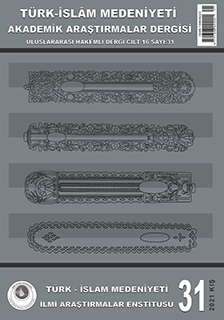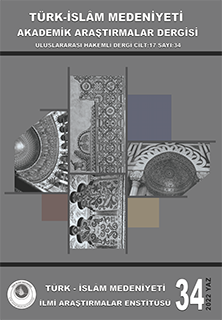University of Chicago Middle East Documentation: Some Notes on Mamluk Studies Review
Keywords:
Mamluks Studies, Mamuks, Makrizi, Egypt, SyriaAbstract
Mamluk Studies Review of the University of Chicago Middle East Documentation Center, which made its first publication in 1997, only accepts articles on the Mamluk studies. In addition to the researches on the political, economic, social and scientific activities of the Mamluks, introductory articles of notable books published on the Mamluks are also included in the journal. In this paper, after providing some information about MSR, some noteworthy studies from the first publication activity to the present will be evaluated. In addition to constituting an important phase of Turkish history, studies on scientific activities that developed in the Mamluk period, many issues that are the subject of the history of economy, and related to the cultural history of the state are not enough in our country. In this context, many other issues related to the history of the Mamluk Turkish State should be examined. Considering the Mamluk studies conducted by the University of Bonn as well as the MSR institutionally, it can be easily observed how important this field of study in the western world.
References
Abouseif, D. B. (1994). Egypt’s Adjustment to Ottoman Rule, Leiden: New York: Köln.
Abouseif, D. B. (1999). Beauty in Arabic Culture, Princeton.
Abouseif, D. B. (2007). Cairo of the Mamluks: A History of Architecture and its Culture, Cairo and London.
Abouseif, D. B. (2014). Practicing Diplomacy in the Mamluk Sultanate: Gifts and Material Culture in the Medieval Islamic World, London. Abouseif, D. B. (1997). The Mahmal Tradition and the Pilgrimage of the Ladies of the Mamluk Court. Mamluk Studies Review, v.1, s.87-96.
Abouseif, D. B. (1998). Sultan Qaytbay's Foundation in Medina, the Madrasah, the Ribat and the Dashishah. Mamluk Studies Review, v.2, s. 61-72.
Abouseif, D. B. (2002). Sultan al-Ghawri and the Arts. Mamluk Studies Review, v.6, s. 71-94.
Amitai, R. (1995). Mongols and Mamluks: The Mamluk-Ilkhanid War, 1260- 1281, Cambridge University Press, New York.
Amitai, R. (1999). David Ayalon, 1914-1998 (obituary). Mamluk Studies Review, v.3.
Antrim, Z. (2014-15). The Politics of Place in the Works of Ibn Taymiyah and Ibn Fadl Allah al-'Umari. Mamluk Studies Review, v. 18, s. 91-111. Berker, H. (2016). Purchasing a Slave in Fourteenth-Century Cairo: Ibn alAkfani’s Book of Observation and Inspection in the Examination of Slaves. Mamluk Studies Review, v. 19, s. 1-23.
Buturovic, A. (2003). The Shadow Play in Mamluk Egypt: The Genre and Its Cultural Implications. Mamluk Studies Review, v.7/1, s.149-176. Clifford, W. W. (1997). Ubi Sumus? Social Theory and Mamluk Studies. Mamluk Studies Review, v.1.
Conermann, S. (2000). Ulrich Haarmann, 1942-1999 (obituary). Mamluk Studies Review, v.4, s. 1-25.
Conermann, S., Saghbini, S. (2002). Awlad al-Nas as Founders of Pious Endowments: The Waqfiyah of Yahya ibn Tughan al-Hasani of the Year 870/1465. Mamluk Studies Review, v.6, s. 21-50.
Firanescu, D. R. (2018). Medieval Arabic Islam and the Culture of Gender: Feminine Voices in al-Suyūṭī’s Literature on Sex and Marriage. Mamluk Studies Review, v. 21, s. 69.86.
Fuess, A. (2001). Rotting Ships and Razed Harbors: The Naval Policy of the Mamluks. Mamluk Studies Review, v.5, (2001), s. 45-71.
Guo, L. (1998). Early Mamluk Syrian Historiography: Al-Yunini’s Dhayl Mir’at al Zaman, Leiden: Brill.
Guo, L. (2004). Commerce, Culture, and Community in a Red Sea Port in the Thirteenth Century: The Arabic documents of Quseir, Leiden: Brill. Guo, L. (1997). Mamluk Historiographic Studies: The State of the Art. Mamluk Studies Review, v.1, s. 15-43.
Haarmann, U. (2001). The Mamluk System of Rule in the Eyes of Western Travelers. Mamluk Studies Review, v.5, s. 1-24.
Humphreys, R. S. (1977). From Saladin to the Mongols: the Ayyubids of Damascus, 1193-1260, Islamic History: A Framework for Inquiry, State University of New York Press.
Humphreys, R. S. (1991). Islamic History: A Framework for Inquiry, Princeton University Press. Humphreys, R. S. (1998). Ayyubids, Mamluks, and the Latin East in the Thirteenth Century. Mamluk Studies Review, v.2, s. 1-17.
Irwin, R. (2000). Under Western Eyes: A History of Mamluk Studies. Mamluk Studies Review, v.4, s. 27-51.
Levanoni, A. (2005). Food and Cooking during the Mamluk Era: Social and Political Implications. Mamluk Studies Review, v.9/2, s. 201-222. Levanoni, A. (2010). Who Were the “Salt of the Earth” in Fifteenth-Century Egypt? Mamluk Studies Review, v. 14, s.63-83.
Levanoni, A. (2011). The Halqah in the Mamluk Army: Why Was it Not Dissolved When It Reached Its Nadir?”, Mamluk Studies Review, v. 15, s. 3765.
Little, Donald P. (1987). Documents as a Source of Mamluk History. Mamluk Studies Review, v.1, s. 1-13.
Little, Donald P. (1998). Documents Related to the Estates of a Merchant and His Wife in Late Fourteenth Century Jerusalem. Mamluk Studies Review, v.2, s. 93-192.
Little, Donald P. (2002). Notes on Mamluk Madrasahs. Mamluk Studies Review, v.6, s. 9-20.
Mazor, A. (2014-15). The “Mansuriyah Legacy”: The Mansuri Amirs, Their Mamluks, and Their Descendants during al-Nasir Muhammad’s Third Reign and After. Mamluk Studies Review, v. 18, s. 1-56.
Meloy, John, L. (2005). Economic Intervention and the Political Economy of the Mamluk State under al-Ashraf Barsbay. Mamluk Studies Review, v.9/2, s. 85103.
Myrne, P. (2018). Women and Men in al-Suyūṭī’s Guides to Sex and Marriage. Mamluk Studies Review, v. 21, s. 47-67.
Ouerfelli, M. (2005). Tsugitaka Sato, Sugar in the Social life of Medieval Islam. Islamic Area Studies. vol. 1 (Leiden-Boston: Brill, 2015). Pp. xii, 232. Mamluk Studies Review, v. 20, s. 247-251.
Petry, Carl F. (1993). Twilight of Majesty: The Reigns of the Mamluk Sultans alAshraf Qaytbay and Qansuh al-Ghawri in Egypt. Washington UniversityPress.
Petry, Carl F. (1991). The Civilian Elite of Cairo in the Later Middle Ages, Princeton University Press.
Petry, Carl F. (1994). Protectors or Praetorians? The Last Mamluk Sultans and Egypt’s Waning as a Great Power, New York State University Press.
Petry, Carl F. (1998). A Geniza for Mamluk Studies? Charitable Trust (Waqf) Documents as a Source for Economic and Social History. Mamluk Studies Review, v.2, s.51-60.
Rahim, Ahmad H. (2013). Obituary: David C. Reisman (1969–2011). Mamluk Studies Review, v. 17, (2013), s. 1-4.
Rapoport, Y. (2007). Women and Gender in Mamluk Society: An Overview, Mamluk Studies Review, v.11/2, s. 1-47.
Rapoport, Y. (2012). Royal Justice and Religious Law: Siyasah and Shari'ah under the Mamluks. Mamluk Studies Review, v. 16, s. 71-102.
Sarraf, S. (2004). Mamluk Furusiyah Literature and Its Antecedents. Mamluk Studies Review, v.8/1, s. 141-200.
Schultz, W. (1999). Mamluk Monetary History: A Review Essay. Mamluk Studies Review, v.3, s. 183-205.
Sopracasa, A. (2016). Venetian Merchants and Alexandrian Officials (End of the Fifteenth–Beginning of the Sixteenth Century). Mamluk Studies Review, v. 19, s.91-100.
Tsugitaka, S. (2004). Sugar in the Economic Life of Mamluk Egypt. Mamluk Studies Review, v.8/2, s. 87-107.
Tsugitaka, S. (2005). Mamluk Studies in Japan: Retrospect and Prospect. Mamluk Studies Review, v.10/1, s. 1.27.
Walker, Bethany J. (2010). From Ceramics to Social Theory: Reflections on Mamluk Archaeology Today. Mamluk Studies Review, v. 14, s. 109-157.
Walker, B., Laparidou, S., Hansen, A., Corbino, C. (2017). Did the Mamluks Have an Environmental Sense? Natural Resource Management in Syrian Villages. Mamluk Studies Review, v. 20, s.167-245.
Woods, E. (1999). The Aqquyunlu: Clan, Confederation, Empire, revised and expanded edition, Salt Lake City.
Downloads
Published
How to Cite
Issue
Section
License

This work is licensed under a Creative Commons Attribution-NonCommercial 4.0 International License.







